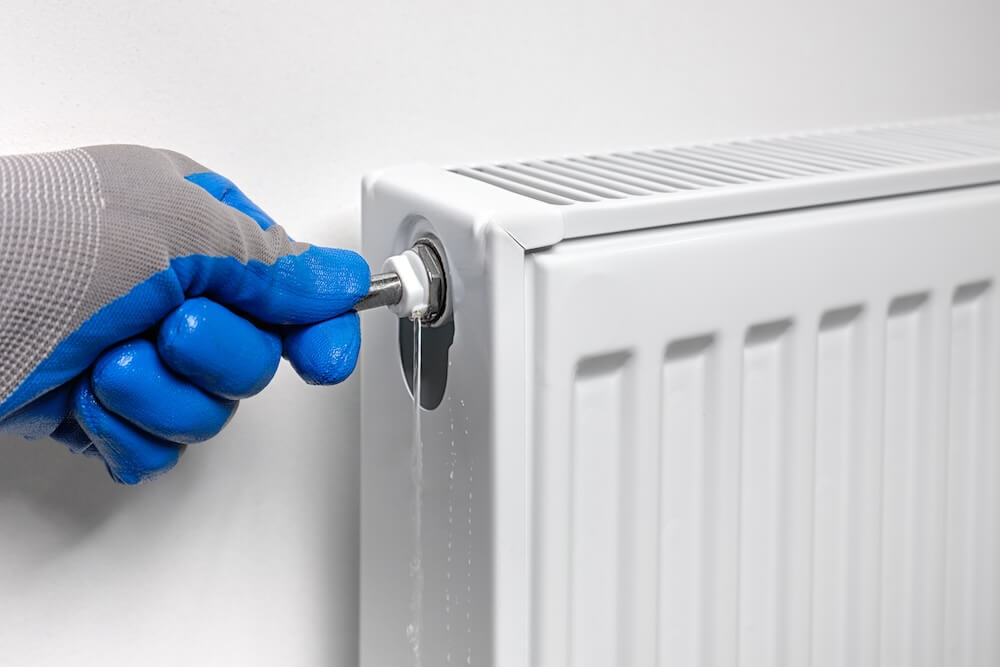How to a Bleed Radiator Properly
If you’ve noticed that your radiator is cold at the top when it’s switched on, or your heating makes bubbling and gurgling noises, it might be time to bleed your radiators.
Bleeding a radiator might be a little daunting if you’ve never done it before. But don’t worry, it’s one of the easiest DIY jobs you can do around the home.

In fact, learning how to bleed a radiator for a beginner is straightforward and it can even help your heating system work much more efficiently – just in time for the colder months.
In this guide, we’ll cover:
- Why bleed radiators in the first place
- How to bleed radiators step by step
- What to do if you don’t have a radiator bleed key
- How long the process takes
- How often you should bleed them
- What happens if you don’t bleed your radiators
What Do We Mean By Bleeding A Radiator?
Bleeding a radiator simply means releasing the trapped air that builds up inside your central heating system. This air stops hot water from circulating around the radiator properly, leaving parts of it cold.
So, Why Bleed Your Radiators?
If there’s air trapped inside your radiator, your home won’t warm up like it should. When you bleed a radiator, you release any trapped air – helping your home heat up faster and more evenly. Bleeding them annually can save you money on your heating bills, too.
Common signs your radiators need bleeding
There are a few telltale signs that you’ll need to bleed a radiator:
- Cold spots at the top of the radiator
- Gurgling or knocking noises when the heating is on
- Higher energy bills as your boiler works harder to compensate
How to Bleed Radiators: Our Step by Step Guide
We’ve asked our boiler engineers to offer their top tips when it comes to bleeding a radiator.
Step 1: Turn Your Heating Off
First things first, always switch off your central heating and let the radiators cool. Bleeding radiators while the system is hot can cause hot water to spray out.
Step 2: Find Your Radiator Bleed Key
Most radiators require a radiator bleed key. You can pick one up from your local DIY shop for around £3. Some modern radiators, particularly in new build homes, can be opened with a flathead screwdriver instead.
Step 3: Find the Bleed Valve
The bleed valve is usually at the top corner of the radiator. It looks like a small round or square hole set inside a screw head.
Place a cloth or small container underneath to catch any water that might spill out.
Step 4: Release the Trapped Air
Insert the radiator bleed key (or screwdriver) into the valve and turn it anti-clockwise slowly. You’ll hear a hissing sound as air escapes, this is completely normal and just means the process is working.
Step 5: Watch for Water
Container at the ready! Once water (not air) begins to flow into your container, turn the valve back clockwise until it’s tight.
Step 6: Check the Boiler Pressure
Bleeding radiators can reduce your boiler’s pressure, so you’ll need to check the pressure gauge on your boiler. It should usually be around 1.5 bar. If it’s too low, you may need to repressurise your boiler.
Step 7: Turn Heating Back On
It’s that simple! Switch your heating back on and check the radiators are warming evenly from top to bottom.
How to Bleed Radiators Without a Key
If you’ve lost your radiator bleed key, don’t panic. Some radiators can be bled with a flathead screwdriver instead. If this is the case, you’ll notice an insert for a standard, flathead screwdriver.
Simply insert the screwdriver into the bleed valve slot and turn slowly anti-clockwise until air starts to escape.
How Long Does It Take to Bleed a Radiator?
Bleeding a radiator is one of the simplest and quickest DIY tasks you can carry out. It should take no more than a couple of minutes per radiator.
How Often Should I Bleed My Radiators?
There’s no fixed schedule, but as a general rule of thumb:
- Once a year (before switching the heating on in autumn) is a good idea
- Any time you notice cold spots at the top of a radiator
- If your system is noisy or inefficient
What Happens If You Don’t Bleed Your Radiators?
If you skip bleeding, trapped air stays in the system and causes:
- Radiators that don’t heat up properly
- Reduced energy efficiency (and higher bills)
- Greater strain on your boiler, which can cause it to breakdown
When to Call a Professional
If you’ve tried bleeding your radiators but they’re still cold, or your boiler pressure keeps dropping, it could signal a more serious problem.
At AddHeat, our heating engineers are on hand to help. They can diagnose issues like leaks, faulty valves and even sludge build-up in the system.
Whether it’s stubborn radiators, boiler repairs, or a full heating service, we’ll get your system running efficiently again. We’re proudly covering Macclesfield, South Manchester and Cheshire. Contact us today.
Bleeding FAQs
Do I need a radiator bleed key?
Most radiators require a bleed key, but some can be bled with a screwdriver instead. If your radiator valve has a flathead screwdriver insert, you can use this instead.
Is bleeding a radiator easy for beginners?
Absolutely! Learning how to bleed a radiator for a beginner is simple and safe if you follow the steps above.
Which radiator should I start with?
Start with the radiator furthest from your boiler and work your way towards the boiler. This helps to push air through your system in one direction.
Can I over-bleed a radiator?
Letting out too much water can lower your boiler’s pressure. To avoid this, stop as soon as water flows steadily.